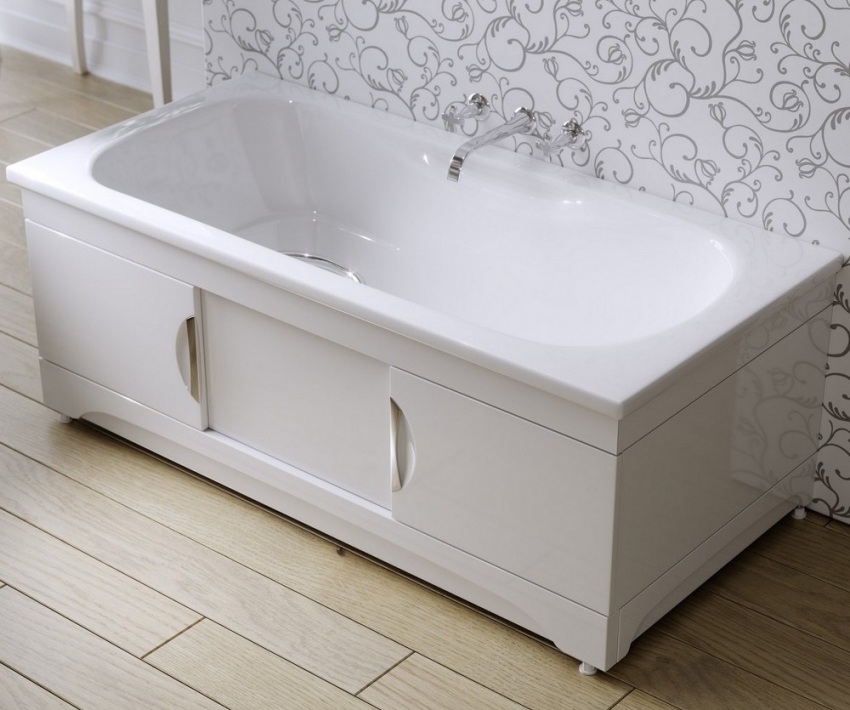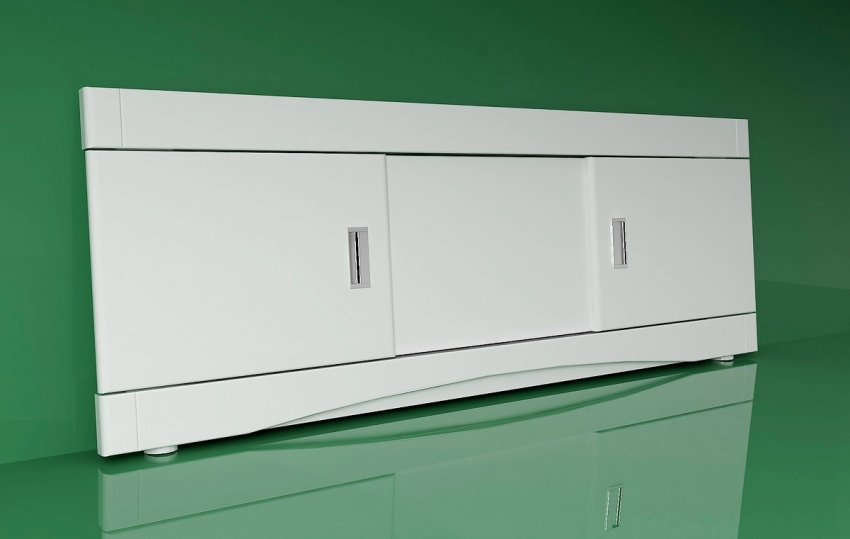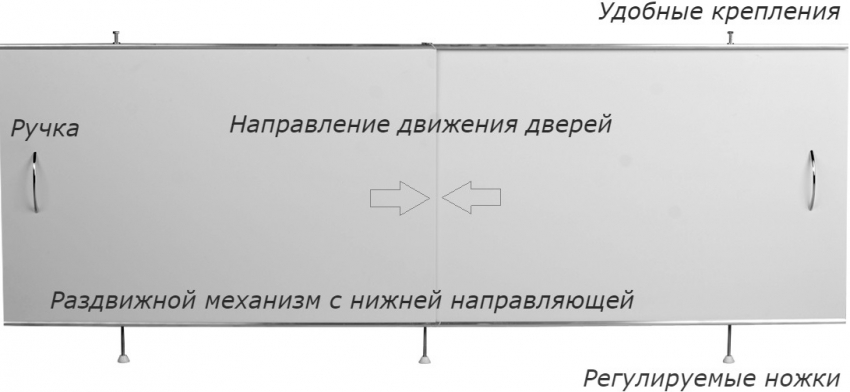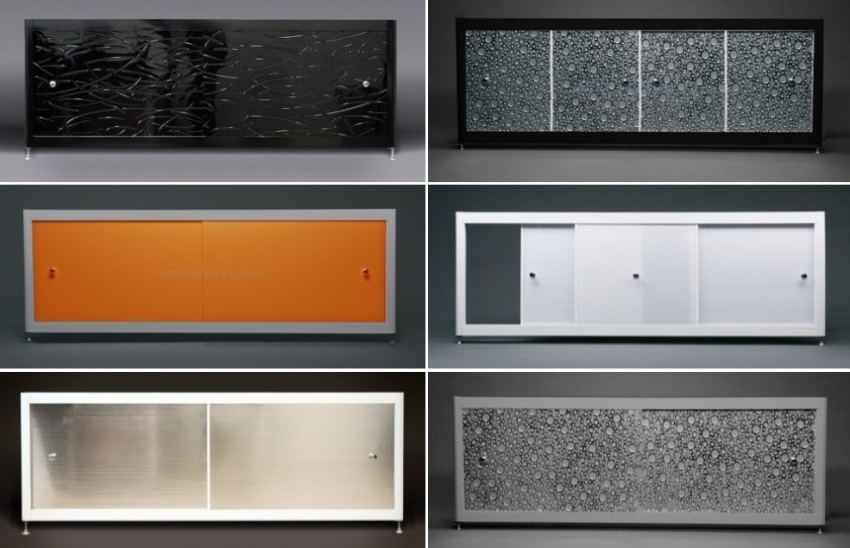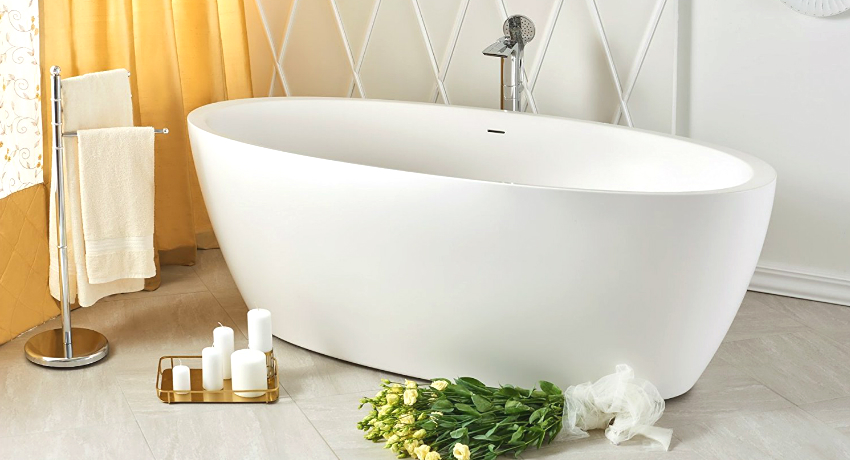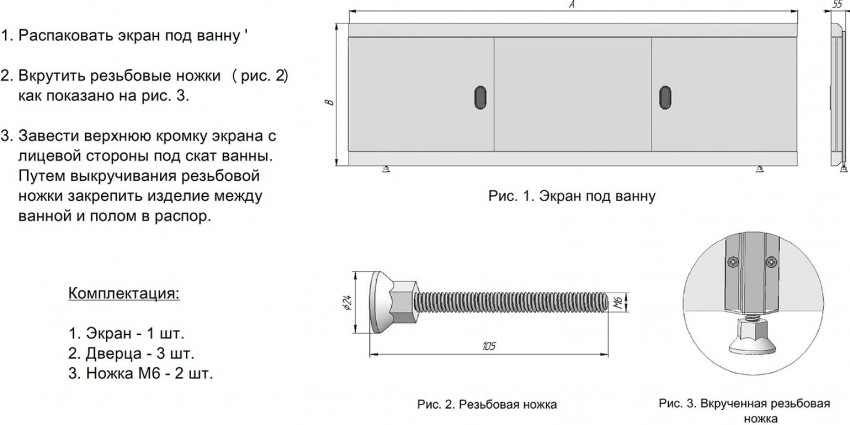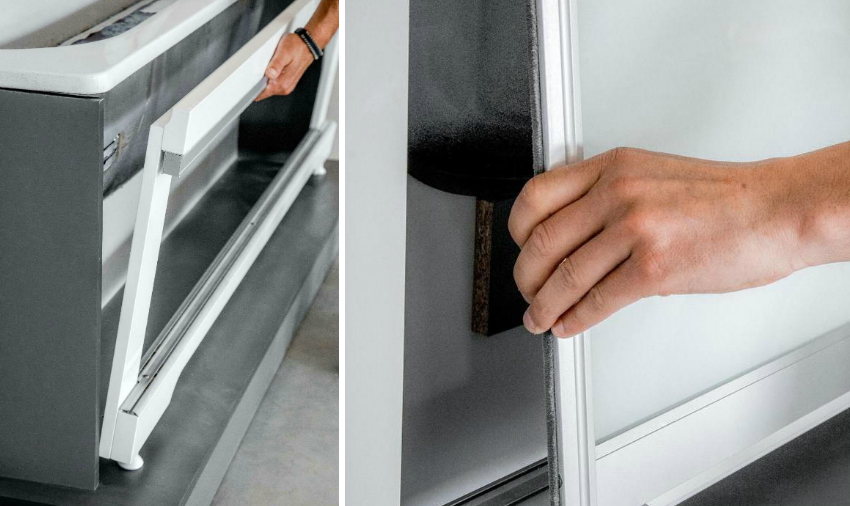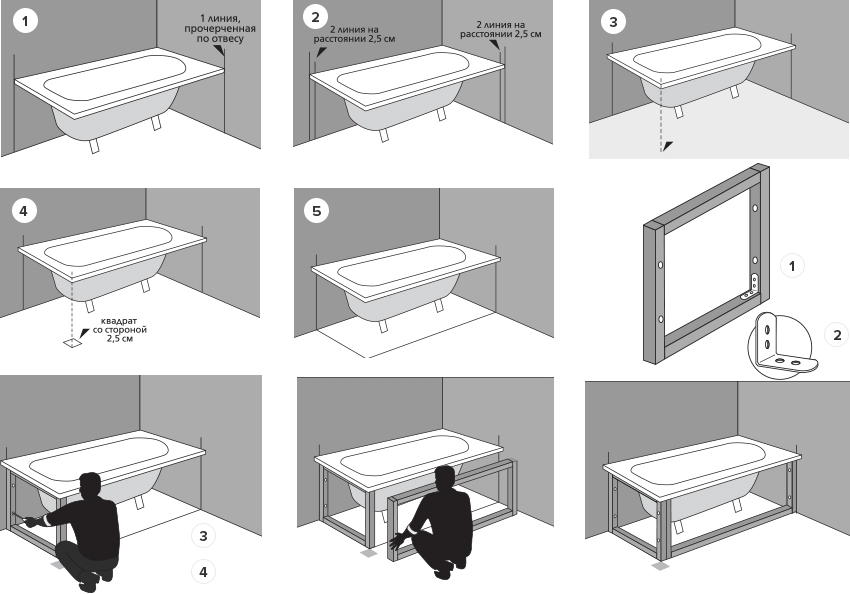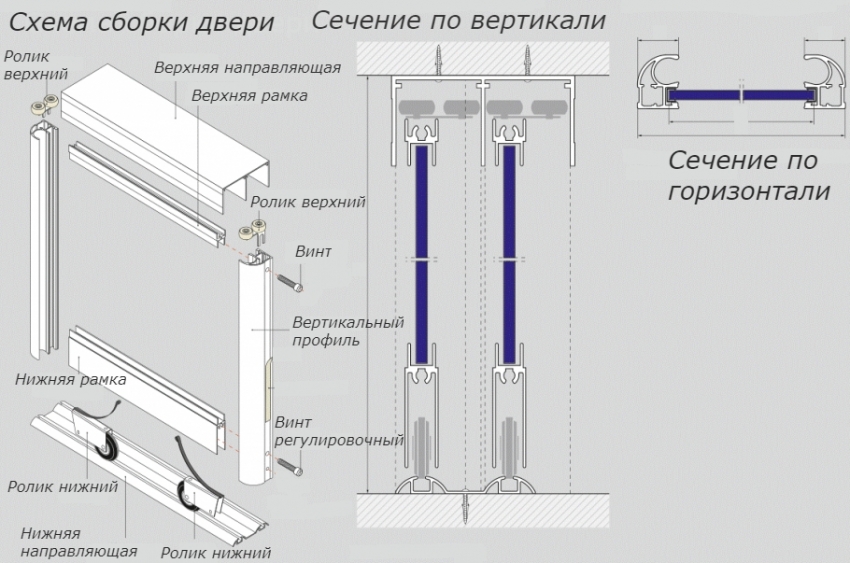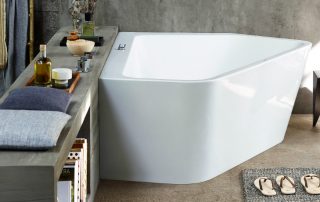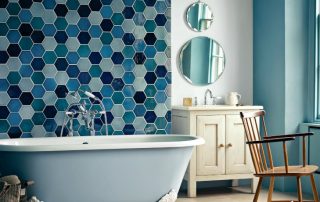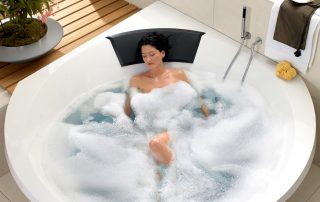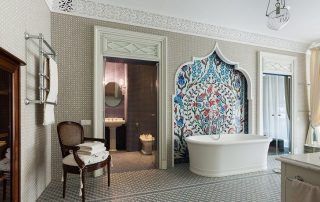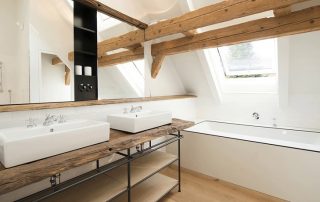A sliding screen for a bathtub is a design that includes two or more sashes and a guide frame. The installation of such a screen allows you to decorate plumbing equipment, as well as save bathroom space and maintain access to pipes in the event of a breakdown. The last point is very important for small-sized apartments.
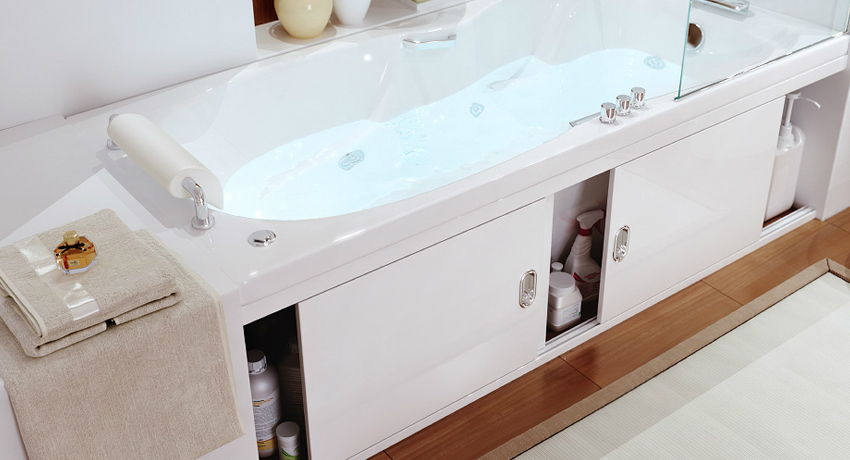
A sliding screen for a bathtub allows you to hide unattractive communications and also to equip additional space for storing household chemicals
Content [Hide]
- 1 Advantages and disadvantages of sliding bath screens
- 2 Sliding screen under the bath: accessories and basic design functions
- 3 Varieties of sliding bath screens: 150 cm and 170 cm
- 4 Plastic screens for a bath
- 5 Screens for acrylic bathtubs
- 6 Features of sliding MDF panels
- 7 Sliding glass and mirror models of screens: increasing the space of the bathroom
- 8 Sliding screen design options
- 9 How to choose a sliding bath screen?
- 10 Making a sliding screen for a bath with your own hands
- 11 Features of installing the screen under the bath: video
Advantages and disadvantages of sliding bath screens
Consider the main advantages of using sliding screens for a bath:
- installation of such a structure is quite simple. Any person who does not have special construction skills and knowledge can carry it out;
- acceptable cost. Today, such screens are made from different materials, so everyone can choose a product for themselves in the right price range;
- simple and convenient dismantling if necessary (for example, when replacing communications under the bathroom);
- a wide range of models that differ not only in color, but also in design.
Note! Doors that slide to the side when opened allow you to save usable room space, which is a definite plus for small apartments.
Of the drawbacks of the sliding model, only one can be noted related to plastic products - the weak durability of the guides. Plastic guides tend to deform after 2–4 years of use, which makes it difficult for the leaves to move.
Sliding screen design
The frame material of sliding structures may vary depending on the price. Today you can find frames made of plastic or aluminum. The most expensive options are equipped with a roller mechanism. Plastic options are distinguished by the lowest cost, as well as resistance to moisture.The main disadvantage of polymer frames is their weak strength. Aluminum frames, unlike plastic ones, are more durable, however, less resistant to moisture.
A variety of color solutions is inherent in both the first and second frame options. But the paint applied to the aluminum parts of the structure tends to come off and peel off over time.
The roller sliding design used for the bathtub panels is most similar to that used in wardrobes. The rollers are fixed on the panel and pass along the guides when the sash is opened. Such panels are convenient and aesthetic, but also more expensive than simple models.
Some variants of screens are equipped with shelves that are used for storing household chemicals, as well as various other accessories. A constructive solution of this type significantly increases the functionality of a bathroom, especially a small one. The cost of bath screens with shelves corresponds to their functionality.
Sliding screen under the bath: accessories and basic design functions
Sliding screens often include the following structural elements:
- panels or doors, the frame of which is made of plastic, aluminum, as well as other metals;
- fittings;
- installation instructions.
Helpful information! Sometimes sliding screens are decorated with different materials. The most common decorative element in this case is a mirror. The use of a mirror has several disadvantages, including: difficult maintenance and very weak strength (the mirror surface is often broken).
Experts recommend using mirror-coated models only as a last resort. For example, when it is necessary to visually expand the space of the bathroom.
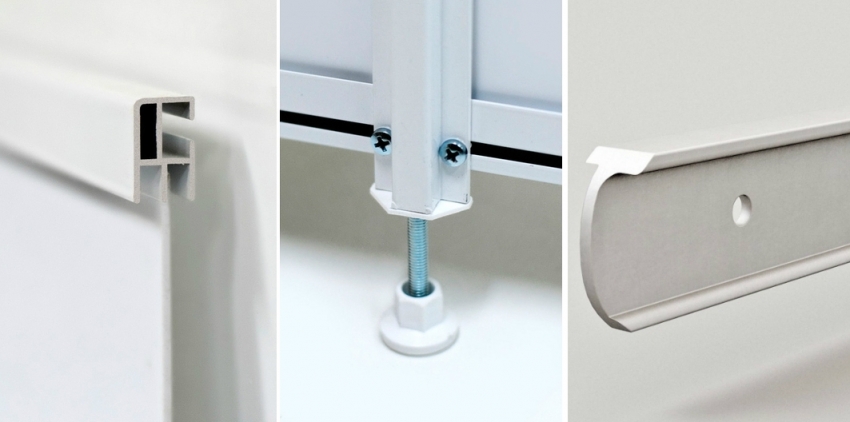
When buying a screen, it is important to pay attention to the quality of fasteners, legs, screws and guides, since the duration of operation of the entire structure depends on these elements.
The simplicity of the design and practicality of such models do not affect their functionality in any way. Let's consider their main functions:
- protection of communications from water ingress on them;
- hiding communications and other items (plunger, household chemicals) that look inorganic in the interior of the bathroom;
- decorative.
You can buy a sliding screen for a bath in any building hypermarket, as well as on the market. A variety of models allows you to choose the right option for any interior.
Varieties of sliding bath screens: 150 cm and 170 cm
These products differ in a small range of sizes. The dimensions of the sliding screens are selected depending on the size of the room and, directly, the bath. In length, there are two options for standard sliding models.
The minimum number of doors in a sliding screen for a 150 cm bathtub is two, and the maximum is four, however, there are exceptions. The height of the screens under the bath ranges from 506 to 560 millimeters. If necessary, you can independently adjust this indicator. The height adjustment is quite simple - using the legs.
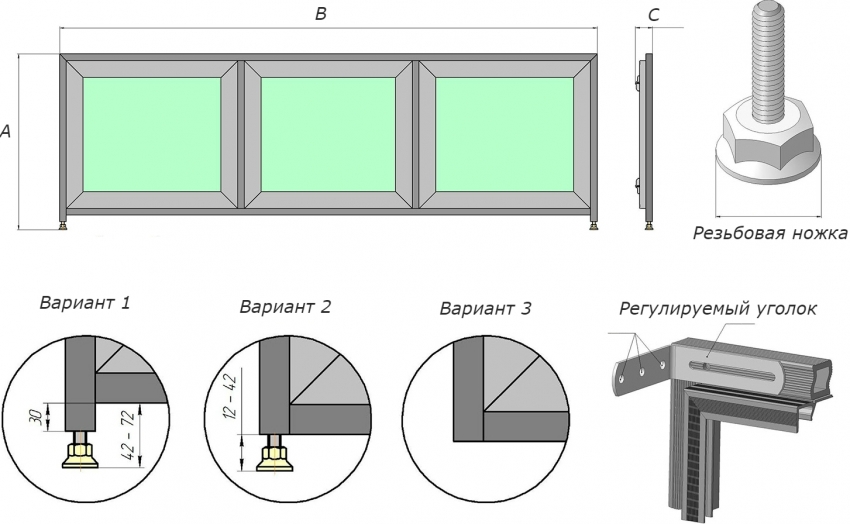
When choosing the size of your bathtub screen, it is important to consider the length and width of all elements such as legs, corners and doors
Sliding bath screens 170 cm
Models that are this length are the most common. Sliding screens for a 170 cm bathtub include from 2 to 4 sashes, which are pushed back due to a mechanism similar to that of a wardrobe. The height of this structure varies from 506 to 560 mm. You can buy a 170 cm sliding screen for a bath in any specialized supermarket or store.
You can purchase products of greater length, for example, screens for a bathtub 180 cm.If you start from the design options of these products, then there are 4 main varieties:
- simple (plastic doors and aluminum frame);
- multifunctional (the ability to adjust the size is added to the previous features);
- products that are produced without frames;
- products obscuring the end of the bathroom bowl.
Thanks to the simple design, you can make your own sliding screen on the bath. Photos and prices of similar products can be viewed in the catalogs of manufacturers, where you can see the use of these structures in real interiors.
Plastic screens for a bath
Models made from this material, as mentioned above, are considered the most common. They became widespread due to their acceptable cost, as well as other positive qualities, including:
- resistance to fungi and mold;
- resistance to temperature changes;
- resistance to decay.
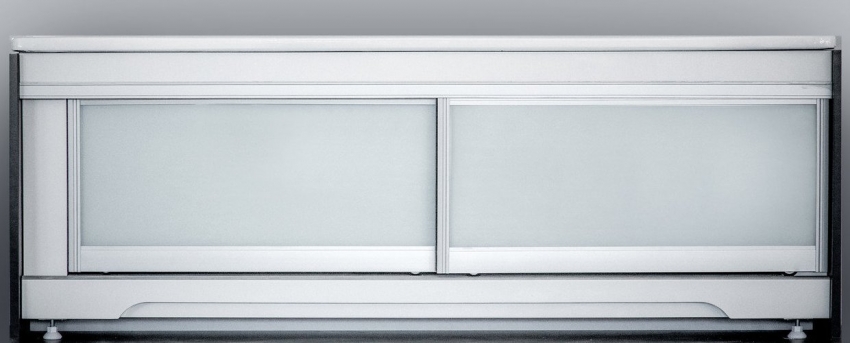
Plastic screens are lightweight, so they will not carry additional load on the supporting structure of the bath
The waterproofness of the plastic material is a huge advantage in determining its prevalence. Constant humidity in the bathroom negatively affects chipboard or MDF products. Over time, they become completely unusable and require replacement. In turn, the plastic does not swell from moisture, and it is also not afraid of rotting. Today in the construction market you can find products of different lengths - from 120 to 180 cm and above. Sliding screens for a bathtub 150 cm - are easy to install, since their length is standard. The same applies to sliding screens for the 170 cm bathtub.
Note! Polymer doors do not require individual maintenance - just wipe them with a regular cloth. Drops and streaks on the polymer material are not as noticeable as, for example, on a mirror surface, which is also a plus.
Screens for acrylic bathtubs
Acrylic sliding panels often come with a bathtub, which is made of the same material. They are distinguished by their originality and, as a rule, consist of a solid panel. They can be purchased separately, however, do not forget that they are only suitable for acrylic baths due to the peculiarities of the attachment.
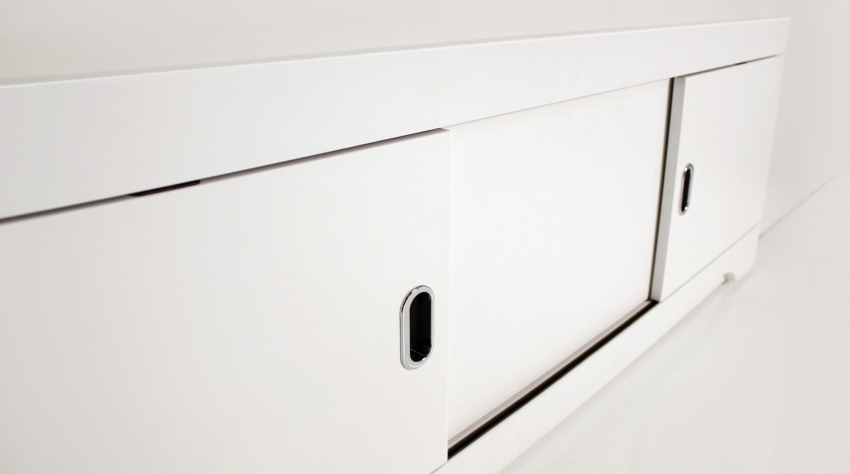
If possible, it is better to purchase a sliding screen complete with the bathroom itself, since this way you can achieve perfect matching of the contours of both structures
The installation of an acrylic screen has several features that need to be noted.
Consider how to install bath screens made of this material:
- first of all, you need to find the center of the on-screen panel and mark it with a marker;
- further, it is necessary to bring part of the panel over the side of the bathroom bowl;
- at this stage, the panel is applied to the bath;
- the place of fixation is marked, which should coincide with the first mark;
- studs are screwed;
- by means of nuts, the corner is fixed, which is needed for fixing the panel;
- holes are made in the marked places (with a drill);
- the structure is fixed with self-tapping screws, which are masked with plugs.
The acrylic construction is reliable and durable. Subject to the installation rules, it will last more than one year.
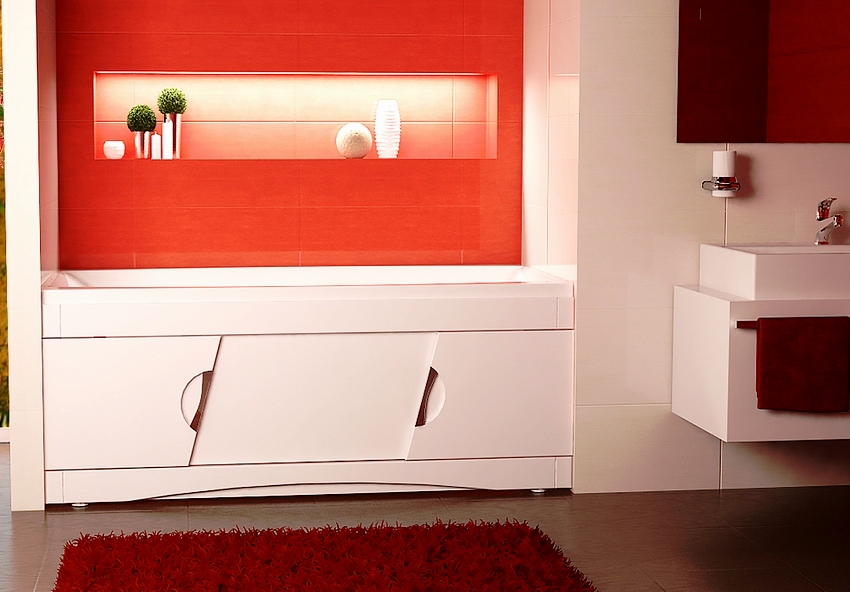
The plastic screen with designer handles blends harmoniously into the bathroom in a contrasting color
Features of sliding MDF panels
MDF is a material that is made by pressing wood chips. Taking into account the humidity of the bathroom, MDF screens are made using moisture-resistant impregnation. Special resins act as such impregnation.
Related article:
Acrylic bath: sizes, shapes and an overview of popular products
How to choose the right size for your bathroom. Popular manufacturers and models of bathtubs. Price policy.
The main advantages of moisture-resistant structures made of MDF are practicality and a rather long service life. Like their polymer counterparts, these products have a wide range of colors. As a decoration, various patterns and patterns are applied to them. To enhance the moisture-resistant qualities, the surface of the MDF board is laminated with plastic films.
A plate made of this material has a rather large mass, so the guides for it are made of durable metals. The MDF construction differs from screens made of other materials in that it often consists of 3 leaves. Moreover, the middle sash is fixed, and the side sash opens as in wardrobes. The most common sizes of MDF bath screens: 150, 160, 170, 180 cm.
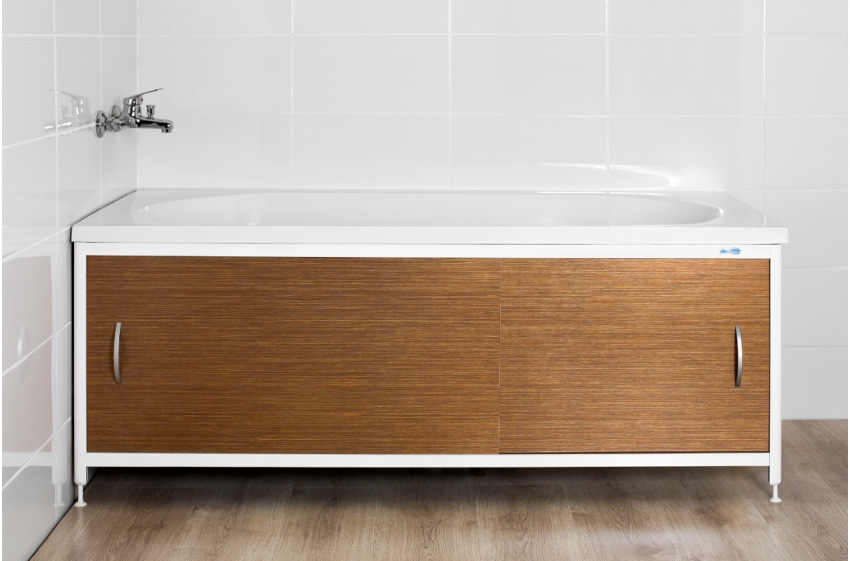
When buying a sliding MDF screen, it is important to clarify whether the material is moisture resistant
Sliding glass and mirror models of screens: increasing the space of the bathroom
Such structures are used much less often than plastic ones. This is due to the fact that they have a very weak resistance to mechanical stress. However, they are of high quality, presentable, and moisture resistance.
The dimensions of such panels correspond to products made from other materials. The easiest way is to buy sliding screens for a bathtub 150 cm. However, glass screens for bathtubs 180 cm are sometimes difficult to find. In this case, many companies are engaged in the production of individual panels to order.
Helpful advice! For people with limited mobility, there are models of sliding panels equipped with special handrails.
The glass of such a panel can be transparent or colored. In turn, the structure can be either glossy or matte. And also glass sliding models can be made with a variety of designs and patterns. The backlight for such a screen looks very impressive.
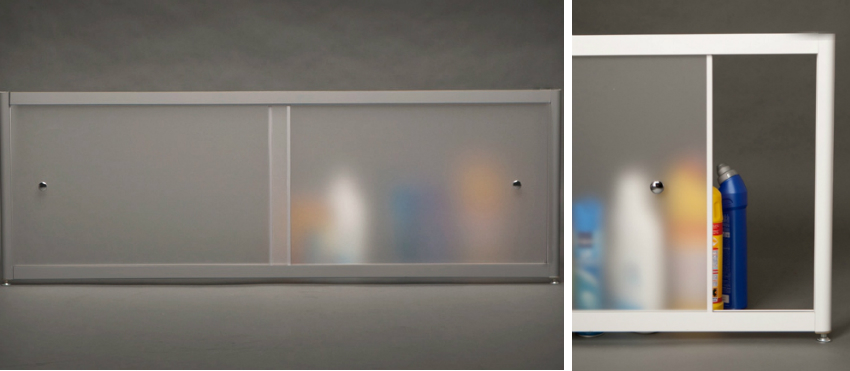
Sliding glass screens are rather fragile, therefore, when choosing this type of construction, it is important to purchase a model that is equipped with a special film that protects against fragments in case of damage
The demand for products, the outer surface of which is represented by a mirror, is quite stable. An element such as a mirror fits perfectly into the interior of the bathroom and allows you to visually expand its space. And also the mirror surface of the panel under the bathroom allows you to add a play of light to the room.
Mirror elements can be installed at different angles, and artificial lighting can be added. The finished design looks very original and presentable. The disadvantages of this option are: the fragility of the panel, difficulties associated with the care of the mirror surface.
Sliding screen design options
The external design of panels of this type can be very different. For example, models equipped with photo printing are very popular. Photo printing can be of two types: regular (2D) and volumetric (3D). The latter option creates the effect of depth of space, which looks very stylish and original.
For rooms decorated in a minimalist style, it is recommended to select monochrome options. The structure of the outer surface for monochromatic models can be either glossy or matte.
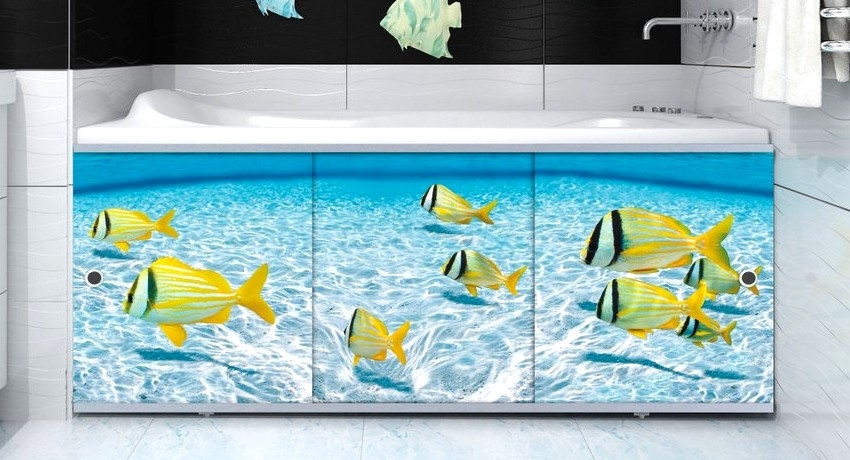
Modern manufacturers offer customers the service of printing any image on a plastic screen, which will allow them to decorate a bathroom in any style.
Not only panels of these products have decorative design. The legs, which serve as a support, are also distinguished by an abundance of design solutions. Expensive structures are equipped with semi-antique legs. The shape of these elements can be very different - from simple geometric shapes to animal paws.
How to choose a sliding bath screen?
Before you buy a screen for a sliding bathtub, you need to think about three main points in advance, such as:
- the size;
- material;
- design.
The above parameters determine the complexity of the installation, ease of use and the operational life of the structure. As mentioned above, the most common sizes of bath screens are 150 and 170 cm. The material and construction are selected individually, depending on the preferences of the owners and the characteristics of a particular room.
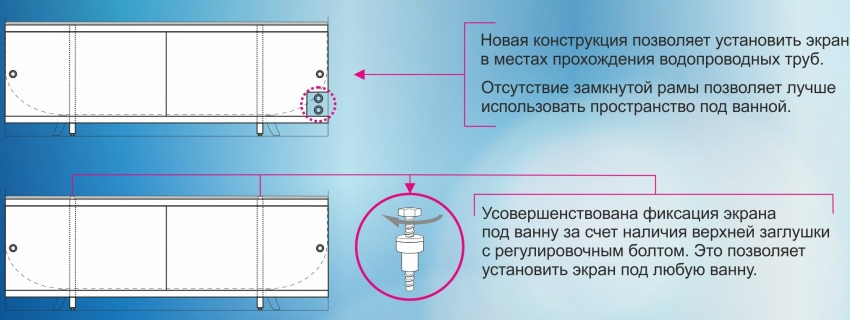
Modern sliding screens are equipped with special features that allow you not to interfere with communications and adjust the height of the structure
In case of purchasing an acrylic bathtub, which has non-standard dimensions, it is recommended to order an individual screen in advance. Otherwise, it will hardly be possible to find the required option. To save money, you can purchase a deaf type product. This model is less functional, however, it is suitable for protecting communications.
Helpful advice! To expand the functionality, they often buy folding screens for the bath. In most cases, such screens are equipped with special shelves. However, it is necessary to take into account the useful area of the room, since the folding model is not the best choice for a standard, small-sized bathroom.
A panel frame made of aluminum is the most suitable option. Experts recommend using plastic frames only if the panel flaps are also made of this material, otherwise the frame may not withstand the load).
Screens made of MDF or chipboard are not recommended to purchase if the bathroom does not have a good ventilation system. Good exhaust communication does not allow excess moisture to linger in the room.
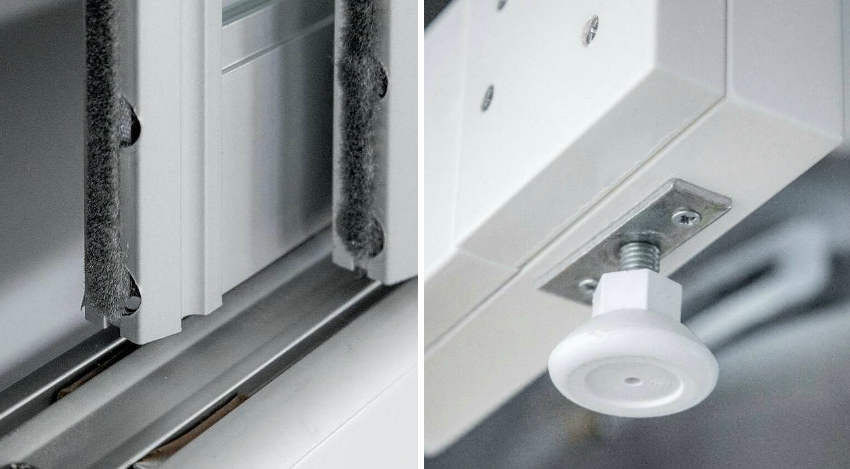
High-quality sliding screens are equipped with functional details that allow not only convenient use of the structure, but also adjust its size if necessary
For small bathrooms, only a sliding model is suitable. When buying such a screen, you need to pay attention to the following factors:
- serviceability of the roller mechanism;
- quality of guiding elements;
- ease of height adjustment of the legs of the product.
The price of screens for baths can be found on the Internet on sites that sell these products. As a rule, in order to buy sliding screens for a 170 cm bathtub, you need to spend from 2 to 5 thousand rubles.
How to install a screen under a sliding bathtub?
The process of installing a plastic panel for this type of bath does not require special construction skills. In order to carry out the installation of this structure, you must carefully study the instructions below.
The algorithm for mounting a plastic screen looks like this:
- first you need to find the middle of the panel. To do this, it is enough to use a regular construction tape;
- further, it is necessary to determine the point that will correspond to the center of the bath rim;
- midpoints are marked with a marker or pencil;
- at this stage, the upper part of the panel must be brought over the side. In order to perform this manipulation, you will need to place the product next to the bathtub and tilt it at an angle of 30–40 °;
- after that, it is necessary to determine the optimal position of the panel and carry out the appropriate marking on the wall;
- further, reinforcing structural elements are fixed, which are often used as corners. Fixation is carried out along the marked lines with a drill and dowel-nails. For screens with a length of 150 cm, it is sufficient to make a reinforcing frame around the perimeter. Bath screens 170 cm require more serious reinforcement, namely 1-2 intermediate posts. Sliding screens for a 180 cm bathtub also require the installation of intermediate racks;
- making a frame for the panel yourself is quite simple: you need to take measurements and cut the strips of the appropriate length from a metal profile. The elements are docked by means of self-tapping screws or corners;
- we put the panel in such a way that it is located close to the frame or metal corners and unscrew the legs (for fixing);
- at this stage, the panel frame is fixed to the frame or metal corners. Decorative elements are used for fixing;
- at the end of the gap between the side of the bath and the frame of the screen, they are filled with a special sealing compound to prevent moisture from entering the structure.
Helpful advice! For convenience during the operation of the sliding system, it is recommended to glue the handles to its doors.
Cast iron baths are the easiest to screen. In this case, it is enough to fix the sliding structure with the legs (you should be careful when fixing the legs of the sliding screen under the 180 cm bathtub). And when shielding an acrylic bathtub, you should be careful, as there is a danger of its lifting when unscrewing the legs. This is due to the fact that an acrylic bowl weighs much less than a cast iron bowl.
Making a sliding screen for a bath with your own hands
Self-manufacturing of a sliding panel is a simple process. If necessary, you can make a solid screen of gypsum board or MDF. The above materials must be selected based on their moisture resistance. After installing a sheet of one or another material, the screen is tiled with ceramic tiles. To access the pipes, a viewing window (hatch) is made in such a screen.
The sliding model is somewhat more difficult to make, however, if you follow the algorithm of actions, then there should be no problems with the installation of such a structure. Below we will look at how to make a sliding screen using an W-shaped profile, as well as the materials that will be required for this.
Consider what materials you need to prepare for making your own sliding screen under the bathtub:
- w-shaped profile. The profile material is selected depending on the material of the dampers. The most commonly used profiles are aluminum or plastic. The width of such a profile should be no less than 20 mm and no more than 24 mm;
- tubes for racks. Experts recommend using steel tubes. The cross-sectional index of the tubes should be approximately 10 mm.
First, you need to thread the ends of the tubes. The screen is fixed by means of special fasteners. Sliding doors are recommended to be made of cheap and easy-to-handle plastic material. Getting plastic doors is quite simple: you need to cut the polymer panel into pieces. In order not to make a mistake in the dimensions, it is recommended to carry out all measurements in advance and carry out the appropriate marking. Then, the resulting parts must be glued together. Transparent glue is best for this.
The work algorithm is as follows:
- First, measurements are taken and the drilling sites are marked.
- The level marks the points at which the fixing elements will be located.
- For the guides (upper and lower), it is necessary to measure the lengths of the w-shaped metal profile.
- The panel is cut into pieces. Thus, the flaps of the required size are obtained.
- Screen assembly.
- Installation of the structure using spacers.
Note! The screen made on the basis of the W-shaped profile has some drawbacks. The main disadvantage of this design is the poor resistance of the profile to moisture.
Screen design is a matter of taste.If you wish, you can make doors from plastic of different colors, glue handles for convenience, equip the structure with shelves for household chemicals.
